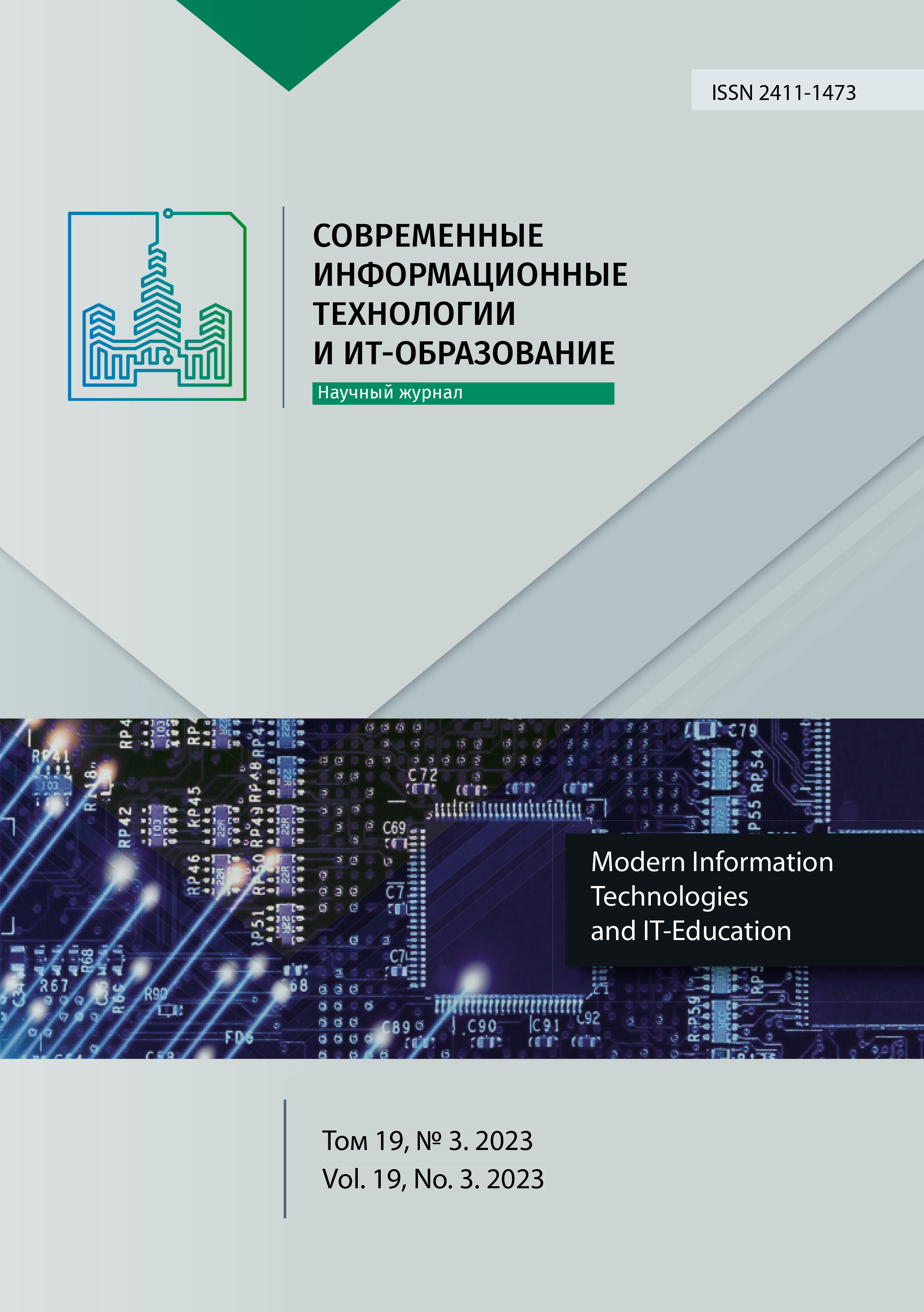Еще один шаг к автоматизации разработки программного обеспечения
Аннотация
Предлагается распространить понятие ООП на практически неограниченную сферу. Объектом может быть любой объект: канал, файл, сеть, электронное устройство и т.д. Для каждого объекта должен быть задан некоторый список возможных операций и параметров. Это оказалось удобным для разработки управляющего кода. Эта концепция была использована для упрощения создания программного обеспечения для управления и мониторинга состояния больших систем со множеством компонентов различной природы. Тематические библиотеки программ значительно повысят эффективность работы системы и уменьшат количество программных ошибок. Можно ожидать, что в будущем подпрограммы будут разрабатываться специалистами, которые вообще не являются программистами.
Литература
2. Farooq M.Sh, Khan S.A., Ahmad F., Islam S., Abid A. An Evaluation Framework and Comparative Analysis of the Widely Used First Programming Languages. PLOS ONE. 2014;9(2):e88941. https://doi.org/10.1371/journal.pone.0088941
3. Khurana D., Koli A., Khatter K., Singh S. Natural language processing: state of the art, current trends and challenges. Multimedia Tools and Applications. 2023;82(3):3713-3744. https://doi.org/10.1007/s11042-022-13428-4
4. Lloyd S. Ultimate Physical Limits to Computation. Nature. 2000;406:1047-1054. https://doi.org/10.1038/35023282
5. Dorenskaya E.A., Kulikovskaya A.A., Semenov Y.A. Yazyk opisaniya problemy i issledovanie ego vozmozhnostej[Exploring Possibilities of Language for Describing the Problem].Modern Information Technologies and IT-Education. 2020;16(3):653-663. (In Russ., abstract in Eng.) https:doi.org/10.25559/SITITO.16.202003.653-663
6. Casado M., Foster N., Guha A. Abstractions for software-defined networks. Communications of the ACM. 2014;57(10):86-95. https://doi.org/10.1145/2661061.2661063
7. Hu Y., Zou D., Peng J., Wu Y., Shan J., Jin H. TreeCen: Building Tree Graph for Scalable Semantic Code Clone Detection. In: Proceedings of the 37th IEEE/ACM International Conference on Automated Software Engineering (ASE '22). New York, NY, USA: Association for Computing Machinery; 2023. Article number: 109. 12 p. https://doi.org/10.1145/3551349.3556927
8. Gong Y., Huang W., Wang W., Lei Y. A survey on software defined networking and its applications. Frontiers of Computer Science. 2015;9:827-845. https://doi.org/10.1007/s11704-015-3448-z
9. Kulikovskya А.А., Dorenskaya Е.А., Semenov Yu.A.Kolichestvennye harakteristiki bezopasnosti programm [Quantitative Security Characteristics of Perl Programs]. Modern Information Technologies and IT-Education. 2022;18(4):855-860. (In Russ., abstract in Eng.) https://doi.org/10.25559/SITITO.18.202204.855-860
10. Dorenskaya Е.А., Semenov Yu.A.Metod opredeleniya kontekstnyh znachenij slov i dokumentov [The determination method for contextual meanings of words and documents]. Modern Information Technologies and IT-Education. 2018;14(4):896-902. (In Russ., abstract in Eng.) https://doi.org/10.25559/SITITO.14.201804.896-902
11. Kádár I. The optimization of a symbolic execution engine for detecting runtime errors. Acta Cybernetica. 2017;23(2):573-597. https://doi.org/10.14232/actacyb.23.2.2017.9
12. Dorenskaya Е.А., Semenov Yu.A. O tehnologii programmirovaniya, orientirovannoj na minimizaciyu oshibok [About the programming techniques, oriented to minimize errors]. Modern Information Technologies and IT-Education. 2017;13(2):50-56. (In Russ., abstract in Eng.) https://doi.org/10.25559/SITITO.2017.2.226
13. Nefdt R.M. Scientific modelling in generative grammar and the dynamic turn in syntax. Linguistics and Philosophy. 2016;39(5):357-394. https://doi.org/10.1007/s10988-016-9193-4
14. Barba-Guaman L.R. et al. Using wolfram software to improve reading comprehension in mathematics for software engineering students. In: 2018 13th Iberian Conference on Information Systems and Technologies (CISTI). Caceres, Spain: IEEE Computer Society; 2018. p. 1-4. https://doi.org/10.23919/CISTI.2018.8399388
15. Nneji G.U., Deng J., Shakher S.S, Monday H.N., Agomuo D., Ukwuoma C.C. A Multimedia Computer Aided Learning Software. In: 2018 IEEE 9th Annual Information Technology, Electronics and Mobile Communication Conference (IEMCON). Vancouver, BC, Canada: IEEE Computer Society; 2018. p. 807-813. https://doi.org/10.1109/IEMCON.2018.8614770
16. Ali S. et al. Explainable Artificial Intelligence (XAI): What we know and what is left to attain Trustworthy Artificial Intelligence. Information Fusion. 2023;99:101805. https://doi.org/10.1016/j.inffus.2023.101805
17. Alkhalifa R., Kochkina E., Zubiaga A. Building for tomorrow: Assessing the temporal persistence of text classifiers. Information Processing & Management. 2023;60(2):103200. https://doi.org/10.1016/j.ipm.2022.103200
18. MacGregor R., Trinder P., Loidl H.-W. Improving GHC Haskell NUMA profiling. In: Proceedings of the 9th ACM SIGPLAN International Workshop on Functional High-Performance and Numerical Computing (FHPNC 2021). New York, NY, USA: Association for Computing Machinery; 2021. p. 1-12. https://doi.org/10.1145/3471873.3472974
19. Shapiro J. Programming language challenges in systems codes: why systems programmers still use C, and what to do about it. In: Proceedings of the 3rd workshop on Programming languages and operating systems: linguistic support for modern operating systems (PLOS '06). New York, NY, USA: Association for Computing Machinery; 2006. 9 p. https://doi.org/10.1145/1215995.1216004
20. Guo Y., Chen Z., Chen L., Xu W., Li Y., Zhou Y., Xu B. Generating Python Type Annotations from Type Inference: How Far Are We? ACM Transactions on Software Engineering and Methodology. 2024;33(5):123. https://doi.org/10.1145/3652153
21. Ziegler A., Kalliamvakou E., Li X. A., Rice A., Rifkin D. Measuring GitHub Copilot's Impact on Productivity. Communications of the ACM. 2024;67(3):54-63. https://doi.org/10.1145/3633453
22. Silva T.C., Boos C.F., Junkes-Cunha M., Azevedo F.M. Automatization of a protocol for the postural assessment of patients with Chronic Obstructive Pulmonary Disease. In: AFRICON 2015. Addis Ababa, Ethiopia: IEEE Computer Society; 2015. p. 1-5. https://doi.org/10.1109/AFRCON.2015.7331918
23. Sonnekalb T., Heinze T.S., Mäder P. Deep security analysis of program code. Empirical Software Engineering. 2022;27(1):2. https://doi.org/10.1007/s10664-021-10029-x
24. Villalón-Fonseca R. The nature of security: A conceptual framework for integral-comprehensive modeling of IT security and cybersecurity. Computers & Security. 2022;120:102805. https://doi.org/10.1016/j.cose.2022.102805
25. Bouke M.A. Software Development Security. In: CISSP Exam Certification Companion. Certification Study Companion Series. Berkeley, CA: Apress; 2023. p. 645-725. https://doi.org/10.1007/979-8-8688-0057-3_10

Это произведение доступно по лицензии Creative Commons «Attribution» («Атрибуция») 4.0 Всемирная.
Редакционная политика журнала основывается на традиционных этических принципах российской научной периодики и строится с учетом этических норм работы редакторов и издателей, закрепленных в Кодексе поведения и руководящих принципах наилучшей практики для редактора журнала (Code of Conduct and Best Practice Guidelines for Journal Editors) и Кодексе поведения для издателя журнала (Code of Conduct for Journal Publishers), разработанных Комитетом по публикационной этике - Committee on Publication Ethics (COPE). В процессе издательской деятельности редколлегия журнала руководствуется международными правилами охраны авторского права, нормами действующего законодательства РФ, международными издательскими стандартами и обязательной ссылке на первоисточник.
Журнал позволяет авторам сохранять авторское право без ограничений. Журнал позволяет авторам сохранить права на публикацию без ограничений.
Издательская политика в области авторского права и архивирования определяются «зеленым цветом» в базе данных SHERPA/RoMEO.
Все статьи распространяются на условиях лицензии Creative Commons «Attribution» («Атрибуция») 4.0 Всемирная, которая позволяет другим использовать, распространять, дополнять эту работу с обязательной ссылкой на оригинальную работу и публикацию в этом журналe.













